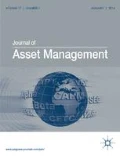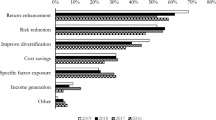Abstract
In this paper, we critically examine the novel concept of fundamental indexation. We argue that fundamental indexation is by definition nothing more than an elegant value strategy, because the weights of stocks in a fundamental index and a market-capitalisation-weighted index only differ as a result of differences in valuation ratios. Moreover, fundamental indices more resemble active investment strategies than classic passive indices because (i) they appear to be at odds with market equilibrium, (ii) they do not represent a buy-and-hold strategy, and (iii) they require several subjective choices. Last but not least, because fundamental indices are primarily designed for simplicity and appeal, they are unlikely to be the most efficient way of benefiting from the value premium. Compared to more sophisticated, multi-factor quantitative strategies, fundamental indexation is likely to be an even more inferior proposition.
Similar content being viewed by others
Notes
See, for example, the papers of Arnott and Markowitz (2008), Perold (2008), Treynor (2008), and Hsu (2008), all of which appeared in the March/April 2008 edition of the Financial Analysts' Journal.
More recently, refinements have been introduced that allow some stocks to be, for example, 50 per cent value and 50 per cent growth, but the principle has remained the same.
Hemminki and Puttonen (2008) document that fundamental indexation has also generated higher returns in Europe. However, as Asness (2006) points out, this does not come as a surprise, given the fact that Fama and French (1998) already observe that the value effect is an international phenomenon. Estrada (2008) prefers an international value strategy above an international fundamental indexation strategy.
As the cross-sectional dispersion in fundamental characteristics might change over time, the exposure to the value factor might also be time-varying. We report the long-term average exposure here.
For a vivid discussion of this point, see Asness (2006).
Except of course for the trivial case in which the two happen to be exactly the same.
The RAFI 1000 still has a slightly negative exposure to the momentum strategy from Fama's website.
This information ratio was derived by taking the reported outperformance of 2.15 per cent and dividing this by the associated tracking error of 4.57 per cent.
References
Arnott, R. D., Hsu, J. and Moore, P. (2005) ‘Fundamental Indexation’, Financial Analysts' Journal, 61 (2), 83–99.
Arnott, R. D. and Markowitz, H. M. (2008) ‘Fundamentally Flawed Indexing: Comments’, Financial Analysts' Journal, 64 (2), 12–14.
Asness, C. (2006) ‘The Value of Fundamental Indexation’, Institutional Investor, (October), 94–99.
Blitz, D. C. and van Vliet, P. (2007) ‘The Volatility Effect’, Journal of Portfolio Management, 34 (1), 102–113.
Chan, L. K. C., Jegadeesh, N. and Lakonishok, J. (1996) ‘Momentum Strategies’, Journal of Finance, 51 (5), 1681–1713.
Estrada, J. (2008) ‘Fundamental Indexation and International Diversification’, Journal of Portfolio Management, 34 (3), 93–109.
Fama, E. F. and French, K. R. (1992) ‘The Cross-Section of Expected Stock Returns’, Journal of Finance, 47 (2), 427–465.
Fama, E. F. and French, K. R. (1998) ‘Values versus Growth: The International Evidence’, Journal of Finance, 53 (6), 1975–1999.
Hemminki, J. and Puttonen, V. (2008) ‘Fundamental Indexation in Europe’, Journal of Asset Management, 8 (6), 401–405.
Hsu, J. (2006) ‘Cap-Weighted Portfolios are Sub-Optimal Portfolios’, Journal of Investment Management, 4 (3), 44–53.
Hsu, J. (2008) ‘Why Fundamental Indexation Might — or Might Not — Work: A Comment’, Financial Analysts' Journal, 64 (2), 17–18.
Jegadeesh, N. (1990) ‘Evidence of Predictable Behavior of Security Returns’, Journal of Finance, 45 (3), 881–898.
Jegadeesh, N. and Titman, S. (1993) ‘Returns to Buying Winners and Selling Losers: Implications for Stock Market Efficiency’, Journal of Finance, 48 (1), 65–91.
Kaplan, P. D. (2008) ‘Why Fundamental Indexation Might — or Might not — Work’, Financial analysts' Journal, 64 (1), 32–39.
Perold, A. F. (2007) ‘Fundamentally Flawed Indexing’, Financial Analysts' Journal, 63 (6), 31–37.
Perold, A. F. (2008) ‘Fundamentally Flawed Indexing: Author Response’, Financial Analysts' Journal, 64 (2), 14–17.
Sloan, R. G. (1996) ‘Do Stock Prices Fully Reflect Information in Accruals and Cash Flows About Future Earnings’, Accounting Review, 71, 289–315.
Treynor, J. (2005) ‘Why Market-Valuation-Indifferent Indexing Works’, Financial Analysts' Journal, 61 (5), 65–69.
Treynor, J. (2008) ‘Fundamentally Flawed Indexing: Comments’, Financial Analysts' Journal, 64 (2), 14.
Acknowledgements
Fundamental Indexation is the patent-pending proprietary property and registered trademark of Research Affiliates LLC. We thank Clifford Asness and Thierry Post for valuable comments on an earlier version of this paper. The views expressed in this paper are not necessarily shared by Robeco or any of its subsidiaries.
Author information
Authors and Affiliations
Corresponding author
Rights and permissions
About this article
Cite this article
Blitz, D., Swinkels, L. Fundamental indexation: An active value strategy in disguise. J Asset Manag 9, 264–269 (2008). https://doi.org/10.1057/jam.2008.23
Received:
Revised:
Published:
Issue Date:
DOI: https://doi.org/10.1057/jam.2008.23




